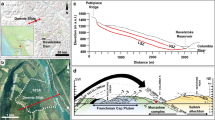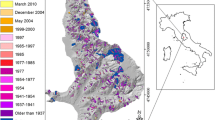Abstract
The deformation and failure of slopes is associated with the formation of geomorphic features reflecting “external slope damage.” Characterizing the spatial and temporal distribution of slope damage is beneficial to understanding the mechanisms and processes underlying slope instability. To date, characterization of slope damage has predominantly been performed using qualitative approaches. In this paper, a new workflow for the quantitative, spatio-temporal characterization of the external slope damage is described and applied to the investigation of the Ten Mile Slide, an active landslide located in southern British Columbia. Since 2006, monitoring activity at the site has included periodic repeat airborne laser scanning (ALS) surveys, which have allowed the creation of a high-detail, three-dimensional database showing the progressive deformation and retrogression of the slide. External slope damage features are manually mapped in the ALS datasets, and slope damage intensity is then computed and displayed on thematic maps. The proposed workflow introduces important new slope damage measures including External Discrete Slope Damage Feature maps (EDSDF), External Slope Damage Intensity Cell (ESDICe) maps, External Slope Damage Intensity Contour (ESDICo) maps and slope damage intensity spatio-temporal plots. The new spatio-temporal damage measures are used to create damage index tables and track changes in slope damage intensity with time at any point within the slide area. The spatio-temporal analysis shows that the distribution of external slope damage features is not homogeneous across the Ten Mile Slide area. In particular, the spatio-temporal damage methodology outlines higher accumulation slope damage rates along the eastern boundary of the slide area, due to the presence of a stream incision that provides kinematic freedom and allows the lateral deformation of the slide and the formation of tensile cracking. The proposed approach in this thesis allows comprehensive, quantitative, and repeatable damage analysis to be undertaken, providing a robust method for characterizing the geomorphic evolution of slopes from a damage perspective. This research methodology provides engineers and geoscientists with a valuable tool for planning subsequent slope investigation and optimizing new or existing monitoring and early-warning systems.













Similar content being viewed by others
References
Agliardi F, Crosta G, Zanchi A (2001) Structural constraints on deep-seated slope deformation kinematics. Eng Geol 59(1–2):83–102. https://doi.org/10.1016/S0013-7952(00)00066-1
Agliardi F, Crosta GB, Meloni F, Valle C, Rivolta C (2013) Structurally controlled instability, damage and slope failure in a porphyry rock mass. Tectonophysics 605:34–47. https://doi.org/10.1016/j.tecto.2013.05.033
Bovis MJ (1985) Earthflows in the interior plateau, Southwest British Columbia. Can Geotech J 22(3):313–334. https://doi.org/10.1139/t85-045
Brideau MA, Stead D. (2011). The influence of three-dimensional kinematic controls on rock slope stability. In Sainsbury D, Hart R, Detournay C, Nelson M (eds.), Continuum and Distinct Element Numerical Modeling in Geomechanics (Proceedings of the 2nd International FLAC/DEM Symposium), paper 04–05
Carlà T, Macciotta R, Hendry M, Martin D, Edwards T, Evans T, Farina P, Intrieri E, Casagli N (2017) Displacement of a landslide retaining wall and application of an enhanced failure forecasting approach. Landslides 15(3):489–505. https://doi.org/10.1007/s10346-017-0887-7
Chigira M (1992) Long-term gravitational deformation of rocks by mass rock creep. Eng Geol 32:157–184. https://doi.org/10.1016/0013-7952(92)90043-X
Clayton A, Stead D, Kinakin D, Wolter A (2017) Engineering geomorphological interpretation of the Mitchell Creek landslide, British Columbia, Canada. Landslides 14(5):1655–1675. https://doi.org/10.1007/s10346-017-0811-1
CloudCompare 2.9 (2017). CloudCompare 2.9 [GPL software] - Retrieved from http://www.cloudcompare.org/
de Vilder SJ, Rosser NJ, Brain M (2017) Forensic analysis of rockfall scars. Geomorphology 295:202–214. https://doi.org/10.1016/j.geomorph.2017.07.005
Dershowitz W, Hermanson J, Follin S, Mauldon M. (2000). Fracture intensity measures in 1-D, 2-D, and 3-D at Aspo, Sweden. In ARMA (ed) Proceedings of the 4th North American rock mechanics symposium. 31 July-3 august 2000. Seattle, WA. Paper ARMA-2000-0849
Donati D, Stead D, Brideau MA, Ghirotti M. (2017). A remote sensing approach for the derivation of numerical modelling input data: insights from the Hope Slide, Canada. In SAIMM (ed) ‘Rock mechanics for Africa’. Proceedings of the ISRM international symposium AfriRock conference. 3-5 October 2017. Paper ISRM AFRIROCK- 2017-066
ESRI (2017). ArcGIS version 10.5. https://www.esri.com/en-us/home
Fell R, Glastonbury J, Hunter G (2007) Rapid landslides: the importance of understanding mechanisms and rupture surface mechanics. Q J Eng Geol and Hydrogeol 40(1):9–27. https://doi.org/10.1144/1470-9236/06-030
Francioni M, Stead D, Clague JJ, Westin A (2018) Identification and analysis of large paleo-landslides at Mount Burnaby, British Columbia. Environ Eng Geosci 24(2):221–235. https://doi.org/10.2113/EEG-1955
Gischig VS, Eberhardt E, Moore JR, Hungr O (2015) On the seismic response of deep-seated rock slope instabilities — insights from numerical modeling. Eng Geol 193:1–18. https://doi.org/10.1016/j.enggeo.2015.04.003
Glastonbury J, Fell R (2008) Geotechnical characteristics of large slow, very slow, and extremely slow landslides. Can Geotech J 45(7):984–1005. https://doi.org/10.1139/T08-021
Software G (2016) Surfer version:14
Havaej M, Stead D, Mayer J, Wolter A. (2014). Modelling the relation between failure kinematics and slope damage in high rock slopes using a lattice scheme approach. In ARMA (ed) Proceedings of the 48th US Rock Mechanics/Geomechanics Symposium. Minneapolis, MN. June 25–28. Paper ARMA-14-7374
Hensold G, Mitchell A, Porter M, Lato M, McDougall S, Gaib S (2017) Ten mile slide, British Columbia: development of a retrogressive translational earth slide in a post-glacial earthflow deposit. In: De Graff JV, Shakoor A (eds) Landslides: putting experience, knowledge and emerging technologies into practice: proceedings of the 3rd north American symposium on landslides. Roanoke, VA, AEG, pp 316–328
Hobson RD (1972) Surface roughness in topography: quantitative approach. In: Chorley RJ (ed) Spatial analysis in geomorphology. Harper and Row, New York, pp 221–245
Jaboyedoff M, Penna I, Pedrazzini A, Baroň I, Crosta GB (2013) An introductory review on gravitational-deformation induced structures, fabrics and modeling. Tectonophysics 605:1–12. https://doi.org/10.1016/j.tecto.2013.06.027
Kromer RA, Hutchinson DJ, Lato M, Gauthier D, Edwards T (2015) Identifying rock slope failure precursors using LiDAR for transportation corridor hazard management. Eng Geol 195:93–103. https://doi.org/10.1016/j.enggeo.2015.05.012
Lato M, Porter M, Hensold G, McDougall S, Kromer R, Gaib S. (2016). Understanding landslide movement and kinematics with airborne LiDAR. In CGS (ed) Proceedings of 69th Canadian Geotechnical Society Conference, GeoVancouver 2016. Vancouver, BC. 2–5 October 2016. Paper 4115
Leshchinsky B. (2016). Contour connection method: a semi-automated method for hazard mapping using LiDAR. In: Aversa S, Cascini L, Picarelli L, Scavia C (eds) Landslides and engineered slopes. Experience, theory and practice: proceedings of the 12th international symposium on landslides. Napoli, Italy, 12-19 June 2016: CRC press, pp. 1267-1273
Locat A, Lerouil S, Bernaden S, Demers D, Jostad HP, Ouehb L (2011) Progressive failures in eastern Canadian and Scandinavian sensitive clays. Can Geotech J 48:1696–1712. https://doi.org/10.1139/t11-059
Macciotta R, Rodriguez J, Hendry M, Martin CD, Edwards T, Evans T (2017) The 10-mile slide north of Lillooet, British Columbia – history, characteristics and monitoring. In: De Graff JV, Shakoor A (eds) Landslides: putting experience, knowledge and emerging technologies into practice: proceedings of the 3rd north American symposium on landslides. AEG, Roanoke, pp 937–948
Martin CD, Stacey PF (2013) Pit slopes in weathered and weak rocks. In: Dight PM (ed) Proceedings of the 2013 international symposium on slope stability in open pit mining and civil engineering, Perth, September, vol 25-27, pp 3–28 Keynote address
Mathews WH, McTaggart KC (1969) The Hope Landslide, British Columbia. Proceedings of the Geological Association of Canada 20: 65–75.
Mitchell A, Whadcoat S, McDougall S, Porter M, Gaib S. (2018). Application of a cellular stress transfer model for retrogressive landslides. In CGS (ed) Transportation Geotechnique - Moving Forward. Proceedings of the 71st Canadian Geotechnical Conference GeoEdmonton 2018. Edmonton, September 23–26. Paper 225
Monger JWH, McMillan WJ (1984). Bedrock geology of Ashcroft (92 I) map area. In Ryder GM (ed) Terrain inventory and quaternary geology Ashcroft, British Columbia, Geological Survey of Canada. Paper no. 74–49. Retrieved from: https://geoscan.nrcan.gc.ca/. GEOSCAN ID 109031
Piteau DR, Ylrea FH, Blown IG (1978) Downie Slide, Columbia River, British Columbia, Canada. In: Voight B (ed) Rockslides and avalanches, vol 1, pp 365–392
Poschmann AS, Klassen KE, Klugman MA, Goodings D (1983) Slope stability study of the south Nation River and portions of the Ottawa River – miscellaneous paper 112. Ontario Geological Survey
Preisig G, Eberhardt E, Smithyman M, Preh A, Bonzanigo L (2016) Hydromechanical rock mass fatigue in deep-seated landslides accompanying seasonal variations in pore pressures. Rock Mech Rock Eng 49(6):2333–2351. https://doi.org/10.1007/s00603-016-0912-5
Roberti G, Ward B, van Wyk de Vries B, Friele P, Perotti L, Clague JJ, Giardino M (2018) Precursory slope distress prior to the 2010 mount meager landslide, British Columbia. Landslides 15(4):637–647. https://doi.org/10.1007/s10346-017-0901-0
Sappington JM, Longshore KM, Thompson DB (2007) Quantifying landscape ruggedness for animal habitat analysis: a case study using bighorn sheep in the Mojave Desert. J Wildl Manage 71(5):1419-1426. https://doi.org/10.2193/2005-723
Stead D, Eberhardt E (2013) Understanding the mechanics of large landslides. Ital. J. Eng. Geol. Environ. Book Ser. 6:85–112. https://doi.org/10.4408/IJEGE.2013-06.B-07
Stead D, Wolter A (2015) A critical review of rock slope failure mechanisms: the importance of structural geology. J Struct Geol 74:1–23. https://doi.org/10.1016/j.jsg.2015.02.002
Stumpf A, Malet JP, Kerle N, Niethammer U, Rothmund S (2013) Image-based mapping of surface fissures for the investigation of landslide dynamics. Geomorphology 186:12–27
Westin, MA (2017) Downie Slide: an integrated remote sensing approach to characterization of a very slow moving landslide. Dissertation, Simon Fraser University
Williams JG, Rosser NJ, Hardy RJ, Brain MJ, Afana AA (2018) Optimising 4-D surface change detection: an approach for capturing rockfall magnitude frequency. Earth Surf Dyn 6(1):101–119. https://doi.org/10.5194/esurf-6-101-2018
Author information
Authors and Affiliations
Corresponding author
Rights and permissions
About this article
Cite this article
Donati, D., Stead, D., Lato, M. et al. Spatio-temporal characterization of slope damage: insights from the Ten Mile Slide, British Columbia, Canada. Landslides 17, 1037–1049 (2020). https://doi.org/10.1007/s10346-020-01352-3
Received:
Accepted:
Published:
Issue Date:
DOI: https://doi.org/10.1007/s10346-020-01352-3




